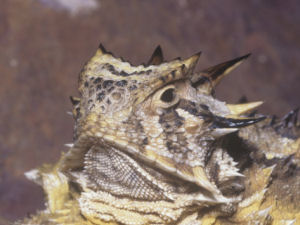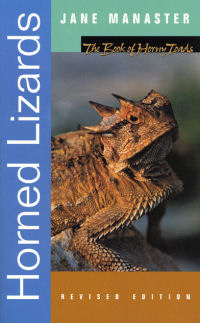
HOME
INTRO
SYMBOLS
ALMANAC
ECONOMY
GEOGRAPHY
STATE MAPS
PEOPLE
FORUM
NEWS
COOL SCHOOLS
STATE QUIZ
STATE LINKS
BOOK STORE
MARKETPLACE
NETSTATE.STORE
NETSTATE.MALL
GUESTBOOK
CONTACT US


Dbl click any word in
document for definition.
Texas State Reptile

Texas State Reptile: Texas Horned Lizard
Photographs
In 1897 Texas Christian University in Fort Worth adopted the horned lizard as the school mascot, but for reasons not entirely clear, called it a horned "frog."
(Rust 8)
In 1967 the Texas horned lizard was designated a threatened species by the Texas Parks and Wildlife Department. Twenty years later, nothing much had changed.
Bart Cox loved Texas horned lizards. Bart Cox was concerned. He was concerned about the declining populations of horned lizards in Texas.
He wanted to do something about it. He called a meeting for like-minded citizens to gather at the Austin Nature Center at Zilker Park. Over 200 people showed up on November 6, 1990.
This was the first meeting of the Horned Lizard Conservation Society (HLCS). Bart Cox was the Society’s first president.
As published in their bylaws
The purpose of the Corporation is to document and publicize the values and conservation needs of horned lizards, to promote horned lizard conservation projects and to assist with horned lizard management initiatives throughout their ranges.
("Horned Lizard Conservation Society")
On May 11, 1993, two and one-half years after that first meeting, House Concurrent Resolution No. 141 was filed at the behest of the Horned Lizard Conservation Society. Society members 10-year old Abraham and his younger brother Noah Holland were a driving force behind this effort, having persuaded their State Representative to introduce this resolution to the Texas State Legislature.
H.C.R. No. 141
HOUSE CONCURRENT RESOLUTION
WHEREAS, The State of Texas traditionally has recognized certain natural life forms commonly found within the state as tangible representations of both the state's proud spirit and its vast and diverse natural heritage by proclaiming them official state symbols; and
WHEREAS, The Texas horned lizard, Phrynosoma cornutum, is well known and much loved by its human neighbors in the hot, arid regions where it makes its home; and
WHEREAS, Known variously as a horned toad, horny toad, and horned frog, this fascinating creature nevertheless is a true lizard, a member of the reptile suborder Lacertilia, with a lineage that has been traced back to the days of the dinosaurs; and
WHEREAS, The horned lizard possesses numerous attributes that qualify it for designation as an official representative of our state; despite a spiny exterior that presents a forbidding appearance, it is at heart a docile and peaceful creature; and
WHEREAS, A skilled hunter, the horned lizard helps to diminish the population of a variety of insect pests; although it prefers a diet of ants, it also will eat grasshoppers, crickets, beetles, pill bugs, and spiders; and
WHEREAS, Its protective coloration and resourcefulness enable it to escape detection by predators, but when threatened it is able to inflate its body to frighten its adversaries; and
WHEREAS, Although these characteristics distinguish the horned lizard as a fitting embodiment of our state and its heritage, it is perhaps most appropriate for designation as an official state symbol because, like many other things truly Texan, it is a threatened species; now, therefore, be it
RESOLVED, That the 73rd Legislature of the State of Texas hereby recognize the Texas horned lizard as an appropriate representative of our state; and, be it further
RESOLVED, That the Texas horned lizard be officially designated the State Reptile of Texas.
The Texas horned lizard became the official state reptile of Texas when Governor Ann Richards signed House Concurrent Resolution No. 141 on June 18, 1993.
Texas Law

Texas State Reptile: Texas Horned Lizard
Photographs
The Texas horned lizard was named the official reptile of the State of Texas by House Concurrent Resolution and is not, therefore, listed in the Texas Statutes.
Only a few of Texas' myriad symbols were actually adopted by an act of the legislature and written into the Texas Statutes.
Sources...
Rust, Carol. "Where have all the horned toads gone?" The Houston Chronicle [Houston] 02 Aug 1998, Section Texas Magazine, 2 Star Edition 8. Print.
"BYLAWS OF THE HORNED LIZARD CONSERVATION SOCIETY." The Horned Lizard Conservation Society. The Horned Lizard Conservation Society, 01 May 2008. Web. 15 Mar 2012.
"Saving the horned toad not an easy task." The Times-Union [Warsaw] 01 Apr 1986, 15a. Print.
Henke, Scott, and Bill Brooks. "10 Years of Horned Lizard Conservation." The Horned Lizard Conservation Society. The Horned Lizard Conservation Society, 2001. Web. 15 Mar 2012.
The State of Texas. Texas Legislature Online. House Concurrent Resolution No. 141. Austin: Texas State Legislature, 1993. Web.
The State of Texas. Texas Legislature Online. Texas Statutes. Austin: Texas State Legislature, 2012. Web.
"Texas Horned Lizard (Phrynosoma cornutum)." Texas Parks and Wildlife Department. Texas Parks and Wildlife Department, n.d. Web. 15 Mar 2012.
Leatherwood, Art. "HORNED LIZARD." The Handbook of Texas Online. Texas State Historical Association., n.d. Web. 15 Mar 2012.
Shearer, Benjamin F. and Barbara S. State Names, Seals, Flags and Symbols: A Historical Guide Third Edition, Revised and Expanded. Westport, Conn: Greenwood Press, 3 Sub edition, 2001.
Additional Information
What is a Horned Lizard?: The Horned Lizard Conservation Society (HLCS).
Horned Lizards Leave for West, South Texas: Texas State Historical Association: The Texas Almanac.
Texas Horned Lizard (Phrynosoma cornutum): Texas Parks and Wildlife Department.
HORNED LIZARD: Texas State Historical Association: The Handbook of Texas Online.
Horned Lizards: by Eric R. Pianka and Wendy L. Hodges, University of Texas.
Phrynosoma cornutum: List of threatened species at iucnredlist.org.

The Encyclopedia of Life
Phrynosoma cornutum texas horned lizard: The Encyclopedia of Life.
Phrynosoma cornutum: The University of Michigan Museum of Zoology: Animal Diversity Web.
Phrynosoma cornutum - (Harlan, 1825) Texas Horned Lizard: A network connecting science with conservation - NatureServe Explorer: An Online Encyclopedia of Life.
Phrynosoma cornutum (Harlan, 1825): Integrated Taxonomic Information System (ITIS) Here you will find authoritative taxonomic information on plants, animals, fungi, and microbes of North America and the world.
State reptiles: Complete list of official state reptiles from NETSTATE.COM.
More symbols & emblems: Complete list of official Texas state symbols from NETSTATE.COM.

Horned Lizards
Jason Glaser
Horned Lizards, by Jason Glaser. 24 pages. Publisher: Capstone Press (January 1, 2006) Reading level: Ages 6+. An introduction to horned lizards including a description of their appearance and information on where they live, what they eat, how they produce young, and the dangers that horned lizards face.

Horned Lizards
Jane Manaster
Horned Lizards (Revised Edition), by Jane Manaster. 94 pages. Publisher: Texas Tech University Press; Revised edition edition (December 15, 2002) Horned lizards, or horny toads, as they are popularly known throughout the West, have long had a particular mystique in American folklore.
The ancient peoples of the Southwest, the Anasazi and the Mimbres, depicted the little lizard on pottery and in petroglyphs. In more recent times, it represented health and happiness in the symbology of Native Americans. Among Americans today, the horny toad has an almost legendary appeal.
Many westerners remember times when the lizards were plentiful and children kept them on string leashes or in boxes as pets. Dried horned lizards were sold in the roadside curio shops along the nation’s major highways.
More recently, as the lizards’ habitat has shrunk and as imported fire ants have supplanted their favored prey, the numbers of horned lizards have declined drastically. In many regions where the little creatures once abounded, they are no longer seen. In Texas, two of the three native species, the Texas horned lizard and the mountain short-horned lizard, are now designated as threatened. Jane Manaster has written this book for a general audience, but she discusses all aspects of the lizards’ biology as well as the horned lizard’s place in the culture of the West. Most of all, she has written it to attract attention to this little animal that deserves our respect and protection.

